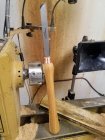Looking for advice on making a handle for a 3/4" skew that I got from Dway Tools.
The tang is just over 1/4" thick by 1/2" wide. The corners of the tang are rounded over, with corner to corner dimension of 33/64". I have one of John Jordan's handles with insert for 1/2" round shafts, but the Dway skew is too big to fit.
My current plan is to glue up 3 pieces of wood to make the handle blank. The middle piece will be the same thickness as the skew, and I'll cut a notch in the end to match the shape of the tang. Glue them up, turn them round, and use epoxy to hold the skew in the handle.
Since I mostly don't do flat work anymore, this sounds like a big hassle. I'm wondering what others use for handles for skews and scrapers and other thngs that don't have round ends on them. Do you just drill as normal, put the square peg in the round hole and fill the gaps with epoxy or shims? Are there aftermarket handles that are designed for flat tangs?
I'd appreciate hearing your ideas on better ways to do this.
Dave
The tang is just over 1/4" thick by 1/2" wide. The corners of the tang are rounded over, with corner to corner dimension of 33/64". I have one of John Jordan's handles with insert for 1/2" round shafts, but the Dway skew is too big to fit.
My current plan is to glue up 3 pieces of wood to make the handle blank. The middle piece will be the same thickness as the skew, and I'll cut a notch in the end to match the shape of the tang. Glue them up, turn them round, and use epoxy to hold the skew in the handle.
Since I mostly don't do flat work anymore, this sounds like a big hassle. I'm wondering what others use for handles for skews and scrapers and other thngs that don't have round ends on them. Do you just drill as normal, put the square peg in the round hole and fill the gaps with epoxy or shims? Are there aftermarket handles that are designed for flat tangs?
I'd appreciate hearing your ideas on better ways to do this.
Dave

